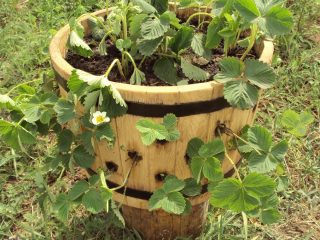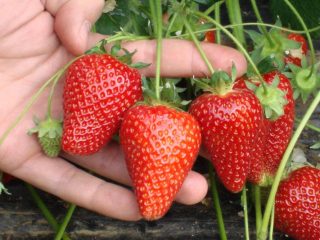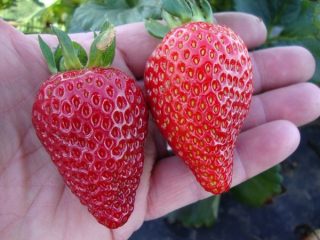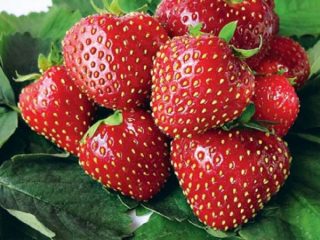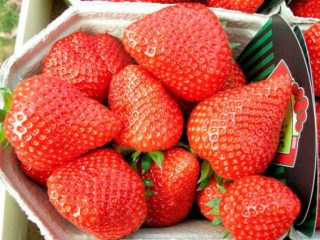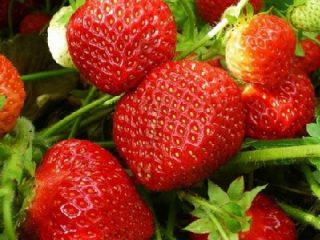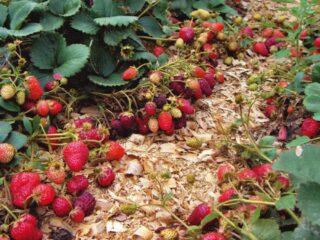Content
Worms in strawberries make the berries unfit for consumption. To prevent damage to the crop, it is necessary to find out which insect larvae settle in the fruits and how you can fight them.
Why did worms appear in strawberries?
Worms in strawberries vary in size and color, but in any case they usually look like larvae, almost indistinguishable to the naked eye. In the smallest of them, the body length may not exceed 2 mm. The colors of worms are gray, white and translucent, as well as brown and black.
Pests can appear for many reasons. But most often their occurrence is provoked by:
- increased soil moisture;
- sudden changes in temperature;
- gross violations in the care of strawberries;
- initially low quality of seedlings.
Very often, worms appear in strawberries if the ripening berries come into contact with the soil.When growing bushes, it is recommended to mulch the soil tightly or use substrates made of non-woven materials.
Signs of appearance
It is not always possible to see small worms on strawberries with the naked eye. However, indirect signs allow one to suspect the presence of pests:
- numerous small holes and passages on the surface of the berries;
- dark spots with an unpleasant odor on the fruit;
- yellowed and withered strawberry leaves;
- slowing down the growth of bushes and their gradual withering.
If you dig up a sick strawberry infected with pests from the ground, you will also see damage on its roots.
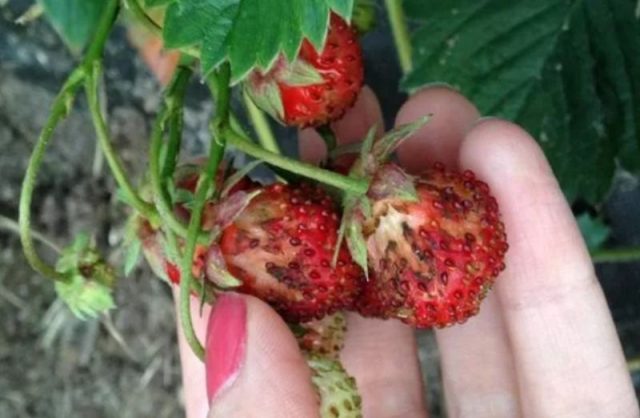
If strawberries are infested with worms, the berries often become smaller and deformed.
What kind of worms eat strawberries
There are quite a few types of strawberry worms. Most often, several pests live in berries.
May beetle larvae
The pest lays eggs on strawberry leaves, and the hatched larvae begin to eat the stems, blades and fruits of the crop. White worms are quite thick, look like caterpillars, and have several pairs of legs. Their body is usually curled into a crescent shape, and fine hairs are visible on the surface of the body. The round head is red-brown, yellowish or straw in color; the jaws of the worms are brown.
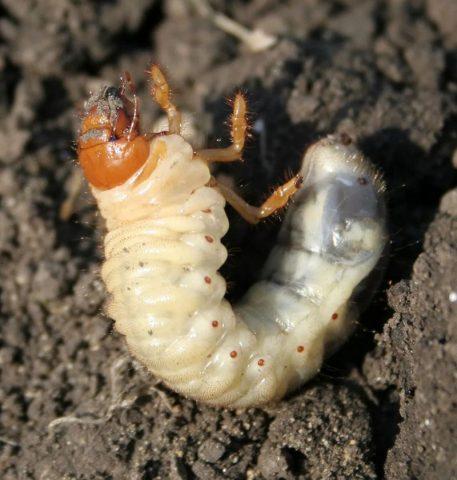
The worms of the cockchafer are quite large, so they can usually be seen with the naked eye.
Strawberry nematode
Worms on garden strawberries often appear due to the presence of a nematode in the soil. This pest lives in the soil and affects both the roots of the bushes and the above-ground parts - flowers, ovaries and ripening fruits. It is almost impossible to see nematode larvae - white worms reach only 1.5 mm in length.But the result of their vital activity is very noticeable - the strawberries begin to wither and stop bearing fruit.
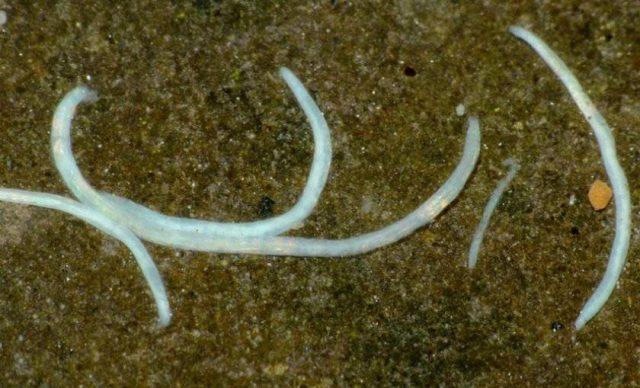
The nematode has increased resistance to chemicals, so it is very difficult to fight it
Kivsyak
The parasite looks like a reddish-black or brown worm with numerous thin legs. Lays eggs on the surface of the soil and under a layer of plant debris. The greens of strawberry bushes and developing berries are eaten by both larvae and adult insects.
Kivsyak shows maximum activity at night and on cloudy days, breeding at a temperature of 22-28 ° C. Worms gnaw holes in the berries, and in such depressions the larvae of the pest can often be found. The parasite also makes cavities in the roots and stems of the crop. Over time, the damaged parts turn black and the strawberries dry out.
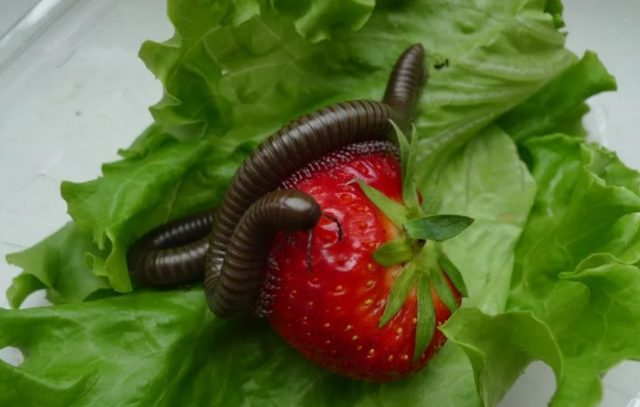
Strawberry berries affected by nodule have an unpleasant odor and are not suitable for food consumption
Thrips
A dangerous microscopic pest reaches 1 mm in length and feeds on flowers and leaves of the plant. It provokes yellowing and drying of the green mass, leaving holes and ulcers on the fruits. The pest's worms are very small, white, and difficult to see with the naked eye. You should focus on the symptoms - light spots on the leaves, deformation of the petals, the presence of sticky discharge and black grains on the plates and fruits of the crop.
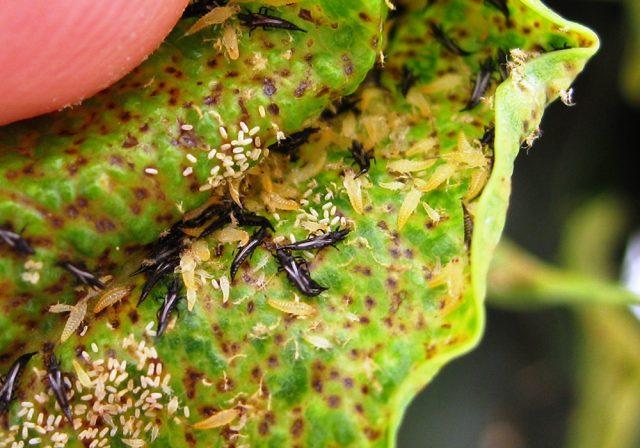
Thrips worms are carriers of dangerous infectious diseases of strawberries
Drosophila
Worms are the larvae of fruit flies. They reach 3 mm in length and have a white body with a gray or yellowish tint.
Small worms live inside strawberry berries and are extremely difficult to notice. Drosophila larvae usually do not pose a danger to human health, even if accidentally ingested. But you need to take into account that the white worm eats strawberries if they have already begun to spoil. If there is a suspicion that the berries are infected with fruit flies, you should refuse to eat them in any case.
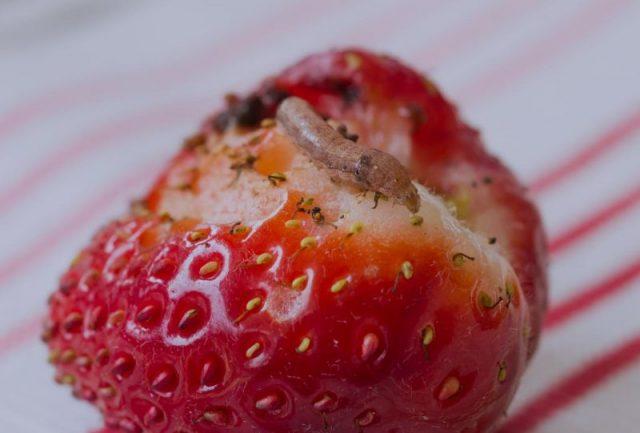
Fruit fly worms often infest strawberries when they are overheated in the sun during cultivation.
Are worms in strawberries dangerous for humans?
White worms in strawberries usually do not pose any harm to humans. If you accidentally swallow the larvae along with the pulp, this will not lead to poisoning. A negative reaction can only occur if a person notices that he has eaten a worm - there is a high probability that he will vomit, but due to disgust, and not due to indigestion.
Harm to strawberries
While wormy strawberries usually pose no danger to humans, parasites can cause serious harm to the plant itself. When berry bushes are damaged by insect larvae:
- stop receiving sufficient nutrition and stop growing;
- turn yellow and gradually fade;
- bear fruit less abundantly.
Berries infected with pests lose their marketable appearance, begin to darken and rot, and spoil even before harvest. The worms move from strawberries to neighboring plants and cause damage to the entire garden.
What to do if there are worms on strawberries
If small worms appear on strawberries, it is necessary to urgently treat the plantings against pests. If there are a large number of parasites, store-bought chemicals are used; if there are few larvae, they resort to homemade solutions and infusions.
Chemicals
If there are white worms in strawberries, you can get rid of them first of all with the help of chemicals. But in this case, processing is carried out several weeks before harvest. Toxins may remain in the fruits, and consuming the berries will be hazardous to health.
Nematophagin Mikopro
The chemical is especially effective against nematodes. It can be used both for signs of crop infection and for prevention. The working solution is made as follows:
- Stir 100 g of the drug in 5 liters of warm water.
- Bring until smooth.
The resulting product is applied to the beds by watering. The consumption rate of the drug is about 2 g of concentrated substance per 1 m2.
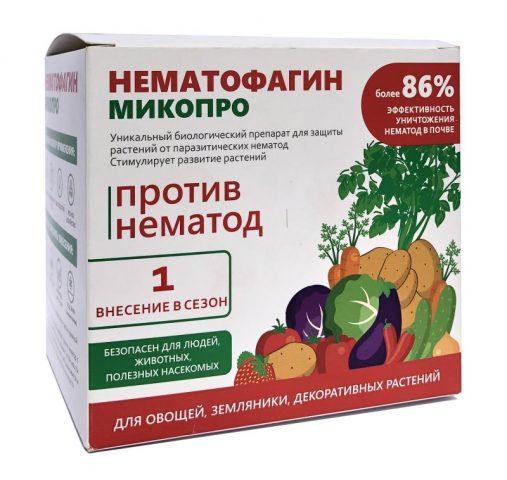
Nematophagin gives the strongest effect when used prophylactically
Karbofos
A drug based on the poison malathion works well against worms and most other pests. The product for treating bushes is prepared as follows:
- Pour 1 liter of water into 60 g of concentrate.
- Stir until a homogeneous liquid is obtained.
- Top up with clean water to 8 liters.
Strawberries are treated with the finished product on a warm but cloudy day. The procedure is best carried out in early spring, but the drug can also be used in the height of summer.
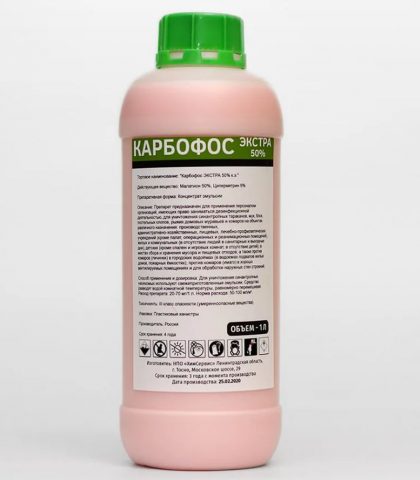
Karbofos contains toxic substances, so it must be used no later than a month before picking berries.
Aktellik
You can fight worms in strawberry roots using an organophosphate insecticide that affects the pests’ nervous system and digestion. The solution for use is prepared as follows:
- Pour 2 ml of the drug into 2 liters of water.
- Stir properly.
The resulting product is used for spraying and watering in dry, windless weather. At 10 m2 Soil consumes approximately 1.5 liters of insecticidal solution.Treatments are carried out once a week until the desired result is obtained; Actellik is applied for the last time 20 days before harvest.
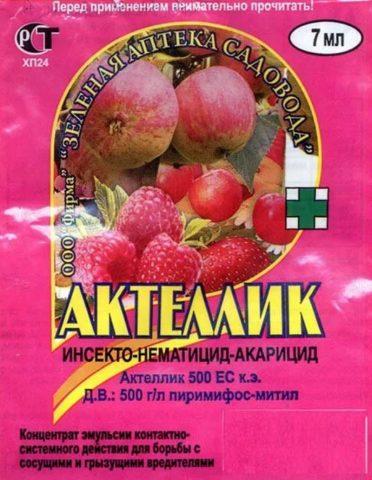
If the worms are tightly stuck around the strawberries, the standard concentration of the Actellik solution can be doubled
Folk remedies
Sometimes folk remedies help get rid of thin worms in strawberries. If there are a large number of parasites, they do not give a good result. But if there are only a few larvae, you should start with homemade solutions, as they are the safest and most gentle.
Garlic infusion
Garlic helps get rid of white worms in strawberry roots. An infusion based on it is made as follows:
- Fresh raw materials are ground in a volume of 100 g.
- Pour the pulp into 5 liters of warm water.
- Leave covered for 3-4 days.
- After the expiration date, filter.
The resulting product is used to water strawberries at the root. Typically 2-3 treatments are required at weekly intervals.
Calendula infusion
For white worms on remontant strawberries, an infusion of fragrant calendula gives a good effect. They do it according to this scheme:
- Pour 70 g of crushed plant flowers into an enamel bucket.
- Pour 5 liters of hot water over the calendula.
- Leave covered until cool.
- Filter the sediment remover.
The infusion is used for spraying and watering once a week. The product does not cause any harm to the bushes; it can be used throughout the season.
Ammonia solution
Ammonia allows you to eliminate black worms on strawberries and white larvae. In low concentrations, it does not harm plants, but has a toxic effect on parasites. Ammonia is used according to this scheme:
- Pour 20 ml of ammonia into a garden bucket.
- Add 10 liters of clean water.
- Mix the ingredients properly.
The solution is used for watering bushes and row spacing in dry weather. The procedure is carried out twice a month.
Agrotechnical control measures
If small worms eat strawberries, you need to reconsider your approach to agricultural practices. In particular, it is recommended:
- completely remove severely damaged plants from the soil and destroy them by burning;
- clear the area of any remnants of berries, leaves and stems of the crop;
- treat the soil after diseased strawberries with strong insecticidal preparations;
- subsequently, do not plant berry bushes in the problem area for another five years.
Agricultural rules recommend using only the best varieties with high immunity levels for cultivation. You need to buy planting material from a trusted manufacturer. Before transferring strawberry seedlings into the ground, it is recommended to soak its roots in warm water at a temperature of about 47 ° C for 15 minutes. Small worms and other pests will die.
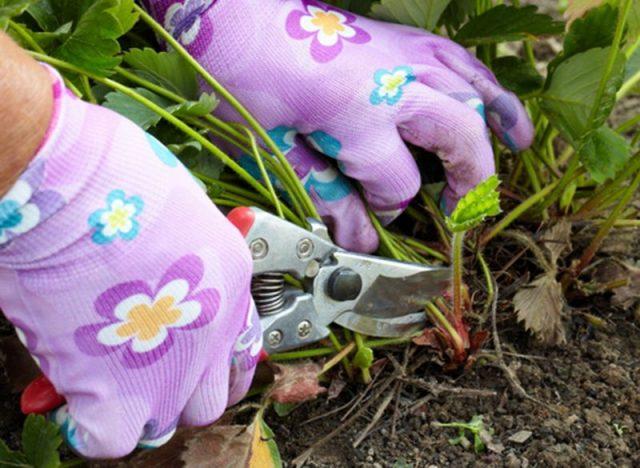
To prevent worms from appearing on strawberries, you need to trim the greens after harvesting - this will not allow the parasites to settle down for the winter.
Preventive measures
High-quality prevention helps prevent the appearance of worms in fresh strawberries. When growing a fruit crop, you must:
- every autumn, dig up the soil properly to bring pests to the surface - then they will die with the arrival of cold weather;
- throughout the season, regularly weed the strawberry beds and loosen the soil;
- Water the plantings moderately, avoiding waterlogging and drying out of the soil;
- timely feed strawberries with minerals that strengthen the crop’s immunity;
- Inspect the beds weekly and begin treatment treatments at the first sign of pests.
When growing strawberries, it is recommended to mulch the soil under them with sawdust, straw, wood chips and other materials when planting the bushes. The protective layer will prevent the berries from coming into contact with the soil surface and will reduce the likelihood of worms appearing.
During the fruiting period, strawberries should be harvested immediately after ripening. Berries should not be left lying on the beds. They will become overripe and then begin to rot, creating a favorable environment for the reproduction of worms and other parasites.
Conclusion
Worms in strawberries most often do not harm human health, but spoil the crop. You can get rid of parasites with chemicals and homemade solutions, but it is best, in principle, to prevent their appearance on the site.
